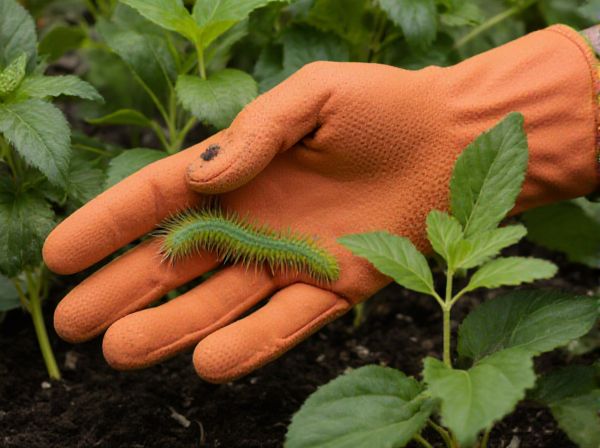
Nematode Infestation vs Aphid Transmission Illustration
Nematode infestation harms plants by attacking roots, causing stunted growth and nutrient deficiencies, whereas aphid transmission spreads viral diseases by feeding on plant sap. Nematodes disrupt water and nutrient uptake directly, while aphids act as vectors, transferring pathogens that induce systemic infections. Effective management requires targeting both the root-feeding nematodes and the sap-sucking aphids to protect crop health and yield.
Table of Comparison
| Aspect | Nematode Infestation | Aphid Transmission |
|---|---|---|
| Definition | Invasion of plant roots by parasitic nematodes causing damage | Aphids acting as vectors transmitting viral plant diseases |
| Common Symptoms | Root galls, stunted growth, yellowing leaves | Leaf curling, mottling, chlorosis, stunted growth |
| Primary Impact | Root system impairment leading to nutrient uptake reduction | Spread of viral pathogens affecting overall plant health |
| Transmission Mode | Soil-borne nematodes penetrate roots directly | Aphids feed on sap, transmitting viruses mechanically |
| Control Strategies | Crop rotation, nematicides, resistant cultivars | Insecticides, biological control, virus-resistant plants |
| Examples of Diseases | Root-knot disease (Meloidogyne spp.) | Potato virus Y, Barley yellow dwarf virus |
Understanding Nematode Infestation: Symptoms and Identification
Nematode infestation manifests through stunted plant growth, root galls or knots, and yellowing or wilting leaves. Identification involves examining root systems for swelling or lesions and using soil assays to detect nematode presence. Early detection through symptom observation and laboratory analysis is critical for effective management of nematode-related crop diseases.
Aphid Transmission: How These Pests Spread Diseases in Gardens
Aphid transmission is a major vector for the spread of viral diseases in gardens, notably transmitting over 100 different plant viruses such as cucumber mosaic virus and potato virus Y. These small sap-sucking insects facilitate disease proliferation by feeding on infected plants and mechanically transferring viruses to healthy ones through their mouthparts. Understanding aphid life cycles and implementing control measures like reflective mulches and biological predators can significantly reduce the incidence of aphid-borne diseases compared to nematode infestations, which primarily affect root systems.
Key Differences Between Nematode and Aphid-Induced Plant Damage
Nematode infestation primarily causes root damage, leading to stunted plant growth and reduced nutrient uptake, while aphid transmission mainly affects aerial parts by sucking sap and spreading viral diseases. Nematodes disrupt root structure, causing galls or lesions that impair water absorption, whereas aphids facilitate rapid virus spread, resulting in leaf curling, yellowing, and overall weakened plant vigor. The differing modes of damage necessitate targeted management strategies to mitigate yield losses caused by these pests in agricultural systems.
Life Cycle Comparison: Nematodes vs Aphids in the Garden Ecosystem
Nematode infestation and aphid transmission differ significantly in their life cycles, impacting the garden ecosystem uniquely. Nematodes undergo multiple larval stages in the soil, feeding on plant roots and causing systemic damage, while aphids reproduce rapidly on plant surfaces, often asexually, transmitting viruses as they feed on phloem sap. Understanding these life cycles aids in targeted management strategies to disrupt infestations and reduce disease spread in gardens.
Common Plant Diseases Caused by Nematodes
Nematode infestation in plants primarily causes root galls, root knot disease, and cyst formation, leading to stunted growth and reduced nutrient uptake. These microscopic worms disrupt root systems, causing wilting, yellowing, and overall decline in plant health, significantly impacting crop yields. Unlike aphid transmission, which primarily spreads viral diseases through sap feeding, nematodes directly damage root tissues, making them a critical target for soil treatment and resistant plant varieties.
Viral and Bacterial Pathogens Spread by Aphids
Aphids serve as primary vectors for the transmission of numerous viral and bacterial pathogens, facilitating their spread across various plant species. Viruses transmitted by aphids, such as Cucumber mosaic virus and Potato virus Y, cause significant agricultural losses globally due to their rapid and efficient dissemination. Unlike nematode infestation, which primarily affects root systems and soil health, aphid-mediated pathogen spread directly impacts plant vascular tissues, resulting in systemic infections and reduced crop yields.
Monitoring and Early Detection of Nematode and Aphid Problems
Effective monitoring of nematode infestation involves regular soil sampling and microscopic examination to detect juvenile nematodes before visible root damage occurs. Early detection of aphid transmission relies on frequent inspection of plant foliage for clusters of aphids and signs of honeydew or sooty mold. Integrating these surveillance methods enables timely pest management interventions, reducing crop loss and disease spread.
Integrated Pest Management Strategies for Nematodes and Aphids
Integrated pest management strategies for nematode infestation and aphid transmission emphasize crop rotation, resistant plant varieties, and biological control agents such as nematode-trapping fungi and predatory wasps. Soil solarization and organic amendments reduce nematode populations, while aphid control benefits from promoting natural enemies like lady beetles and lacewings alongside selective insecticide use. Monitoring pest populations and implementing threshold-based interventions optimize pest suppression and minimize environmental impact.
Biological Control Options: Natural Predators and Soil Health
Natural predators like lady beetles, lacewings, and predatory nematodes play a crucial role in biological control of nematode infestations and aphid transmission by reducing pest populations effectively. Enhancing soil health through organic amendments, crop rotation, and maintaining beneficial microbial communities supports nematode-suppressive environments and strengthens plant resilience against aphid attacks. Integrated management combining natural predators and improved soil conditions offers sustainable solutions to minimize chemical pesticide reliance and control both nematode and aphid-related diseases.
Preventive Measures: Protecting Your Garden from Nematodes and Aphids
Implement crop rotation and use nematode-resistant plant varieties to reduce nematode infestation in gardens. Apply insecticidal soaps or neem oil to control aphid populations effectively, while introducing beneficial insects like ladybugs enhances natural pest management. Maintaining healthy soil with organic matter and avoiding overwatering strengthens plant resilience against both nematodes and aphids.
Nematode Infestation vs Aphid Transmission Infographic

 gardendif.com
gardendif.com